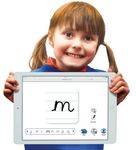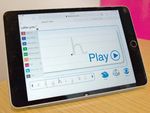Cursive Handwriting HOME USERS' GUIDE - Whitehouse Primary School
←
→
Page content transcription
If your browser does not render page correctly, please read the page content below
Cursive Handwriting
Cursive HOME USERS’ GUIDE
Handwriting Welcome to Letter-join!
HOME USERS’ GUIDE To help teach handwriting, your school uses the
Letter-join handwriting programme. As part of
FOR PARENTS AND PUPILS your school’s subscription parents and carers
can access Letter-join for free to help children
practise at home.
This guide shows how to use Letter-join’s key
resources for home learning.CONTENTS Log-in and get started
2 Getting started
with Letter-join at home
Logging in on PCs and
tablets.
3 Letter-join menu
Getting to know your way
around Letter-join resources.
Login:
From the Letter-join
home page, choose
5 Class Word Banks Desktop or Tablet
login.
Using Word Banks produced Enter the username
by class teachers. and swipecode
(tablets) or password
(PCs) issued to you by
your child’s school.
Select your child’s
7 Early Years class name from the
menu. Or if you don’t
Resources to know click Free-Play.
introduce cursive
handwriting.
9 Key Stage 1
Material to teach other
character sets and to
practise handwriting.
11 Key Stage 2
Exercises and practical
methods to help reach
National Curriculum
expectations. Google Chrome Mozilla Firefox Apple Safari
Letter-join is an advanced web site that is compatible with most internet browsers
on desktop computers as well as on iPads, Windows and Android tablets.
Internet Expolrer and Microsoft Edge cannot display cursive fonts correctly and are
not recommended for Letter-join.
1 2The Letter-join menu Choosing letters and
words to practise
Letter-join Workflow: Animation to Worksheet
Animations for individual letters include voiced instructions
and link to an accompanying practice worksheet.
Choose a letter to watch Animations with
spoken instructions
Touch-screen activities for Practice worksheets
IWBs, iPads and tablets accompany all sections
3 4Access your classroom’s
Word Bank at home
Word animations that are produced for pupils by class teachers can be
watched and practised at home on PCs and iPads/tablets.
How to find your classroom’s Word Bank
5) ‘Watch’ 6) ‘Try’
Select ‘Play’ to see the word being Choose ‘Try’ to practise writing
written on an iPad or tablet. words on an iPad or tablet.
7) ‘Activities’
1) Log in to Letter-join 2) Choose ‘Fun’
Use your school’s Letter-join Home-School/Tablet log-in and Select ‘Word Bank’ from the
select your child’s classroom name. Letter-join ‘Fun’ menu.
Use the Activities pull-down
menu to select Spelling List
or Word Search.
The words displayed are
selected from the current
Word Bank collection.
3) Select a Word Bank 4) Select a word to watch
Use the pull-down menu to Select a word either on-screen or from the pull-down
select a Word Bank. menu, to watch and practice.
Letter-join’s Word Searches are designed for iPad and tablets. They are
both fun and practical, reinforcing spellings and are easily printed for
handwriting practice.
5 6Early Years, Foundation Stage
Letter-join Phonics
Colourful, touch-screen handwriting activities. Combine cursive handwriting with phonics
in an easy and seamless way
Children can practise tracing the
phonemes on whiteboards or
tablets. Schools can choose
between lead-in or no lead-in
Letter-join fonts for the words which
accompany the phonemes.
Magic Patterns
Magic Patterns and Develop writing skills with pre-cursive patterns
Magic Words
Under the Fun tab you’ll find activities
designed to offer touch-screen tracing
practice for pupils at home.
Magic Patterns can be used to trace
Letter-join’s pre-cursive patterns and
other shapes in a choice of fun
palettes. Magic Words allows any word Pre-cursive patterns cover all writing shapes.
to be typed onto the screen and then
Letter-join provides a selection of fun
written over using a finger or a stylus
pre-cursive patterns for EYFS pupils
for letter and word practice.
that cover all handwriting movements.
These encourage fine and gross motor
Write it Right! Magic Words
skills as a foundation to cursive
A new, fun activity handwriting.
Write it Right selects groups of pictures Letter-join’s pre-cursive patterns are
with words (easy, medium and hard) for grouped into logical sets of similar
Watch patterns, such as jellies, with fun sounds.
children to trace. shapes, and each pattern is animated,
The activity has accompanied by exciting sounds.
accompanying
Patterns can be watched on a PC or
sounds and fun
tablet and children can follow the
animations to
shapes by ‘air writing’
encourage
children to play Finer control can be gained by finger
and practice writing on tablets or with a pencil
their letter using the worksheets. Worksheets
shapes over Fun worksheets are available for all the consist of lines of patterns for tracing
pattern sets for handwriting practice using
again. Write it Right! Practice tracing patterns on IWBs or tablets. pencils and crayons. using a pencil or crayon and a simple
drawing which can be ‘coloured-in’
using the patterns of that group.
7 8Key Stage 1
At home, Letter-join is the
perfect handwriting companion
for KS1 children with easy access
to the same resources as school.
With gentle encouragement
Lets try...
children will be aiming to
produce neat handwriting with KS1 SPaG Revision
consistent spacing and
letter sizes. Letter-join offers a series of
worksheets to support KS1 SATs
Practicing handwriting exercises which are not only great for
both on tablets and with pencils improving handwriting, but are
on worksheets can be fun with also perfect for the revision of
real improvements achieved spelling, punctuation and
surprisingly quickly. grammar.
The following KS1 pages cover a There are 18 fun worksheets
variety of Letter-join resources to aimed to boost your children’s
achieve this including speedy ‘on confidence so they are SATs
the go’ iPad/tablet activities and ready. These worksheets can be
a multitude of worksheets for downloaded from Resources >
real handwriting practice. Printouts > KS1.
When using Letter-join at home
parents can be sure that they
are using the same letterforms
and resources as chosen at KS1 is the time to introduce new
school. characters; capital letters, numbers,
printed letters, mathematical symbols
and punctuation. Letter-join animates all
of these to show the correct formation
and provides ready-made worksheets.
9 13
10Key Stage 2
Longer passages of
text, written speedily
and neatly, are the
aims of KS2.
The Printouts tab in
Letter-join’s Why not try...
Resources section has
many practice
SATs WORKSHEETS
worksheets. They
A series of worksheets to help with SATs
cover a selection of
revision as well as reinforcing cursive
curriculum topics and
handwriting. Titles include Synonyms,
are perfect for real Antonyms and Prepositions, all topics that
handwriting practice will have been taught at school and all can
at home. be found in Resources > Prinarouts > KS2.
To build up handwriting
speed and stamina
children can use the
Dictation Exercises
which will help with
learning to write longer
passages of text.
Don’t forget to practise
Printed Letters by using
the form-filling and
labelling worksheets.
11 12Pencil grip and seating
11
How to sit comfortably
Sit with a straight
back, not leaning
over the page
2
✓
Sit right back
in the seat
3
3
Paper positioning for
Pull the right-handed children.
chair close
in to the
table
How to hold a pencil correctly using the tripod pencil grip
Both right and left handed children should be 1 Grip the pencil with your index finger and thumb with
encouraged to use the tripod grip which allows the pen/ the nib pointing away.
pencil to be held securely whilst allowing controlled 2 With your free hand, spin the pencil from underneath.
movements of the pen/pencil nib.
3 Use your middle finger to support the underside
of the pencil.
Seating and handwriting positioning for
left-handed children
Left-handed children may find it difficult to follow
right-handed teachers as they demonstrate letter
formation (and vice versa). Teachers should demonstrate
to left-handers on an individual or group basis.
• Left-handed pupils should sit to the left of a
right-handed child so that they are not competing
for space.
Tripod grip for left-handed children. Paper positioning for
• Pupils should position the paper/book to their left side left-handed children
and slanted, as shown.
• Pencils should not be held too close to the point as
this can interrupt pupils’ line of vision.
• Extra practice with left-to-right exercises may be
necessary before pupils write left-to-right automatically.
✓
www.letter-join.co.uk
13 17You can also read



























































